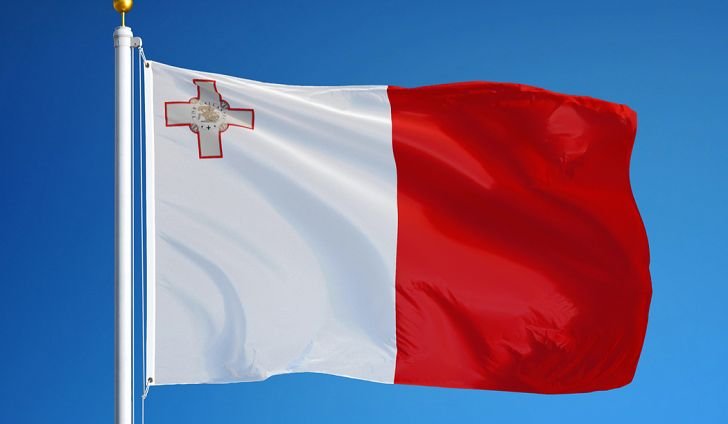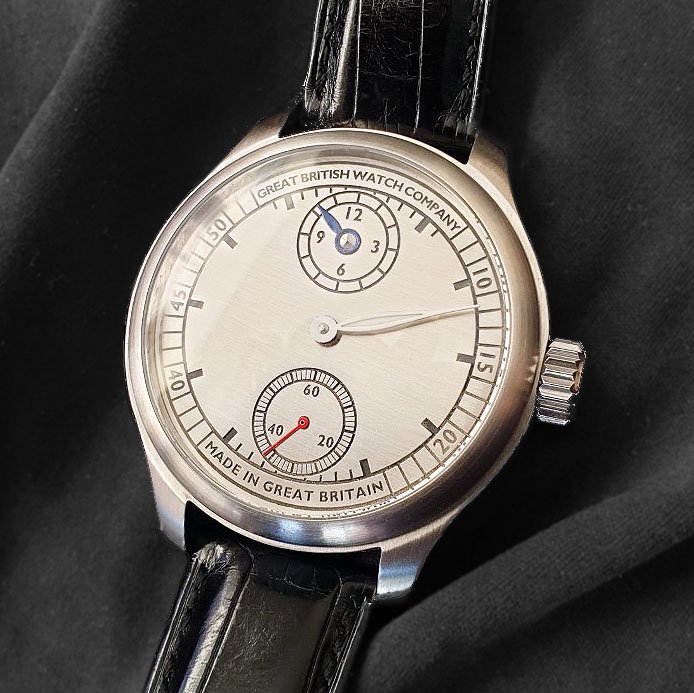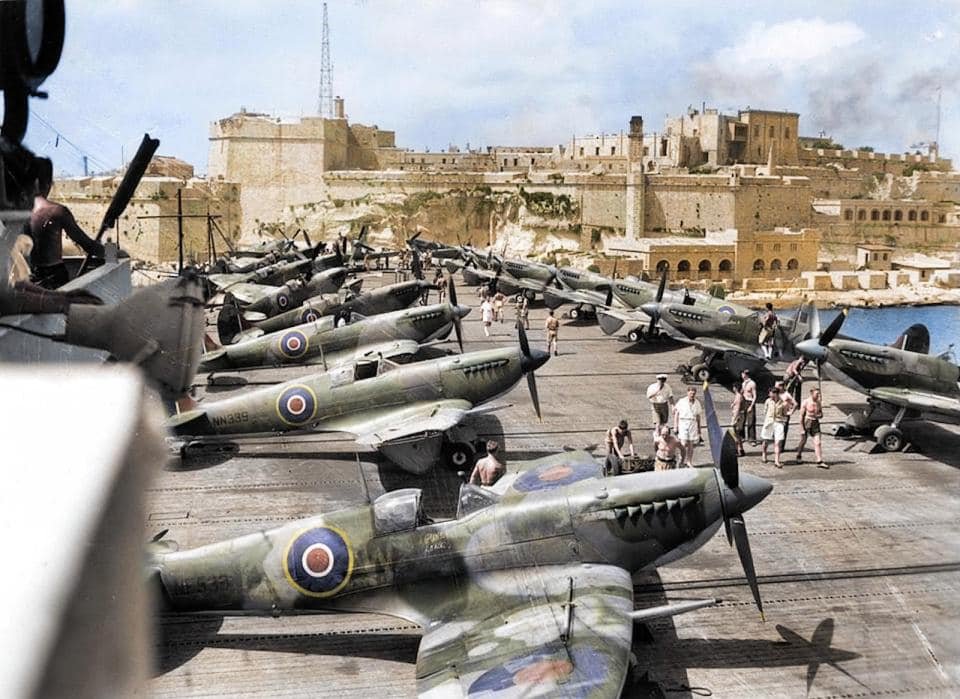As we discussed in the last Sortie about the Legend of the Spitfire, which you can read here, the Spitfire is recognised worldwide as a fighter capable of turning the tide of a battle.
Part of this legacy is that after its famous success in the Battle of Britain, the Spitfire found itself in high demand not just in Europe, but also in conflicts in Africa, Asia and even the USSR – where over 1,300 Spitfires were delivered.
The Spitfire’s international story begins with its first deployment outside of Britain; in the defence of the tiny Mediterranean island of Malta.

Malta had been a British colony since 1813. For the British, it was the strategic lynchpin in their Mediterranean presence; guarding all shipping from the Suez Canal to Gibraltar and from southern Europe to northern Africa.
The Siege of Malta
In April 1940, as the Battle of France still raged, the French Prime Minister had tried to convince Winston Churchill to cede Malta to the Italians in an effort of appeasement. Churchill refused to consider this as an option. He was validated when Mussolini declared war on the Allies on 10th June 1940, having had no intention of staying out of the war.
After declaring war, the Italian air force began an immediate and persistent bombing campaign against Malta, making efforts to destroy the island’s airfields, ports and infrastructure. There was also an additional focus on trying to starve the local population by sinking the supply shipping upon which the tiny island was dependant. This conflict became known as the Siege of Malta.
With limited anti-aircraft batteries present, air defence of the island initially rested on just 3 operational Gloster Sea Gladiators. Named Faith, Hope and Charity, none of their pilots had prior combat experience. Despite this, the obsolete bi-planes still managed to inflict losses on the Regia Aeronautica.
Malta’s DEFENCE
Along with this handful of fighter aircraft, the island was defended by three battalions of troops from South West England – who together formed the 1st Malta Infantry Brigade. Although fewer than 2,500 fighting men, they were tasked with the defence and repair of the island’s strategic points and to prepare for what was seen as the inevitable amphibious and paratrooper assault.

My grandfather, Donald Andrews, in Malta in 1941
My grandfather, Donald Andrews, was part of the 1st Malta Infantry Brigade. He fought with the “A” Company of the 2nd Battalion of the Devonshire Regiment in WW2. From 1940 he was stationed at Hal Far Airfield on the southern tip of Malta. Hal Far was one of 3 major airfields on Malta. Later it became a central staging area for the RAF’s Spitfire presence.
The Unsinkable Carrier
After Italy’s entry into the war, Winston Churchill resolved to make Malta “an unsinkable aircraft carrier”. Slowly their perilous situation began to improve as small numbers of Hurricanes made their way to the island.
Although an effective deterrent against the Italians, the Hurricanes found themselves severely outclassed once the Germans turned their attention to the Mediterranean conflict. After the consecutive failures of the Italians in North Africa, the Germans intervened by sending over one of their most talented generals, Erwin Rommel, with his Afrika Korps.
With Rommel stationed in Libya, the Germans became acutely aware of Malta’s importance in controlling Mediterranean shipping; in November 1941 the Axis lost 77% of all supply shipping in the Mediterranean. That same month Albert Kesselring was appointed as the Wehrmacht’s Commander-in-Chief South. He became resolved to either control or neutralise Malta.
The Spitfire Arrives
Through relentless and sustained attacks, the attrition rate on the island’s defences was high. By January 1942, of the 340 fighters that had been sent to Malta only 28 remained in service. The RAF pilots on Malta described the Hurricanes as “useless” against the improved Bf109F. They petitioned that their only hope lay in the Spitfire.
Their pleas were heard, and in March 1942 the first Spitfires arrived. These were the latest variant of the aircraft, the Mark 5 (V). It became the first ever operational deployment of Spitfires outside of mainland Britain.

The Spitfire Mark 5 (V)
The Mark 5 Spitfire was a significant improvement over the previous variants. It became the Spitfire type that would go on to be produced in the greatest numbers during the war. Engine horsepower had increased by 50%, the rate of climb had almost doubled and the range had tripled. For the first time, the Spitfire now also had better performance than its main rival, the Bf109, at higher altitudes.
Operation Herkules
In April 1942, under the name of Operation Herkules, Hitler and Mussolini agreed on a plan to invade Malta. The plan revolved around an amphibious landing of up to 70,000 troops. The landings would be preceded by almost 30,000 elite paratroopers airdropped onto the island. These would secure both the airfields and high ground.
By this time, the Allied military presence on the island had risen to 26,000 men organised into 4 brigades. Although formidable, these troops would have been severely outnumbered and outgunned.
Much like the Battle of Britain, before their invasion could begin, the Axis powers first needed to gain air superiority.
Immediately upon their arrival in Malta, the Spitfires were pressed into action. Their impact was instantly felt by the Italian and German aircraft. The Luftwaffe however, had been keeping a keen eye on the Spitfire’s arrival and made determined bombing efforts to destroy the Spitfires both on the ground and while they were still being transported. Of 72 Spitfires delivered in March and April 1942, by mid-April only a single Spitfire remained operational.
Relentless Bombing Campaign

Malta suffered an unprecedented amount of devastation as a result of the relentless bombing campaign
One story my grandfather told me about his time on Malta, was during a German air raid at Hal Far. Bombers had been were sighted and the air raid sirens began to sound. So, my grandfather began quickly pushing Spitfires off the runway into their hangars. As the last Spitfire had been secured, he made his way to the relative safety of the bomb shelter. However, the Luftwaffe’s bombs started to explode around him forcing him to swiftly return to the hangar.
Taking cover alongside the Spitfires, he remained there until the explosions stopped. As the smoke cleared, he discovered that the bomb shelter he had been unable to reach had been hit directly with a bomb; all inside had instantly perished – including his best friend.
The Siege is Lifted
Despite the continued assault and the loss of carriers HMS Eagle and HMS Ark Royal to German U-Boats, the British were able to keep up the supply of Spitfires to Malta. Soon the supply of aircraft to the island outstripped their losses. This was helped by the Americans delivering Spitfires with their carrier USS Wasp, which transported a further 47 Spitfires in April 1942.

Spitfires arriving into Malta’s Grand Harbour by aircraft carrier
By the end May 1942, close to 100 Spitfires were available to defend the skies over Malta. In stark contrast, the Luftwaffe now had only 30 fighters and 34 bombers still operational in the area; out of 500 total aircraft just two months prior.
The failure of the Axis to wrest control of Malta from the Allies meant that the RAF and Navy could maintain control of the Mediterranean. This starved Rommel’s Afrika Korps of both supplies and reinforcements. The Siege of Malta finally ended in November 1942. Just 6 months later the whole of North Africa had been captured by Allies.
Once again, the Spitfire has proven itself pivotal in helping to resolve one of the major conflicts of the war in the Allies’ favour.
The Bravery of Malta
Hal Far airfield, where my grandfather was based, had a total of 2,300 tons of bombs dropped on it during the Siege of Malta. To put this in context, the amount of ordinance dropped on this one airfield was around 23% of the explosive energy of the Hiroshima nuclear bomb. Despite this, the airfield continued to remain operational throughout the conflict.
In total, Malta had the equivalent of one and a half Hiroshima bombs delivered by the Luftwaffe and Regia Aeronautica over 2 years. This gave it the title of “most bombed place on Earth”.

Due to their bravery in facing the most sustained bombing campaign of the war, the people of Malta were awarded the George Cross by King George VI on 15th April 1942. The medal now forms part of Malta’s flag.
My Grandfather’s Journey
After the successful defence of Malta, my grandfather along with the 2nd Devons were at the forefront of the invasion of Sicily in 1943, where approximately 1 in 7 of their fighting men were either killed or wounded. At Regalbuto they had a particularly tough fight against the Herman Göring Panzer Division – the Luftwaffe chief’s personal elite guard. However, with the support of a Canadian armoured division they were able to push the Nazis off the island.
After securing Sicily, they then made another successful amphibious landing on the Italian mainland. They pushed into Italy before being withdrawn back to the UK to prepare for D-Day. Landing at Gold Beach on the first day, they managed to make good inroads into Normandy. As they moved through Belgium and Holland they became part of the 7th Armoured Division (Desert Rats). Together they fought their way to Hamburg. They remained in the city until they were demobbed in 1946.

Photograph of A Company of the 2nd Devons taken the day before D-Day. My grandfather, Donald Andrews, is circled
Wartime Stories
Like many of his generation, my Grandad spoke very little about his wartime experiences. 5 years of almost constant fighting, where survival seemed to depend on luck rather than skill, had a deep and lasting impact. Many of his closest friends were either killed or suffered life changing injuries.
However, my Grandad did occasionally reminisce about in his jovial West Country accent. While facts from the war are recorded in books and museums, such personal records of life in WW2 are often forgotten.
He mentioned that while he was stationed in Malta, the Italian air force were not considered a serious threat. They would often drop their bombs and make an escape as soon as anti-aircraft fire was aimed at them; often meaning their bombs landed harmlessly out at sea. After the arrival of the Luftwaffe however, their situation became considerably more perilous. The Germans always aggressively pressing home their attack.
Another memorable comment was that after D-Day and their march through France. He said their biggest fear was not the Germans but the American air force. Whenever an American plane was spotted, the order would come to hide. On more than one occasion they came under attack from both low-level strafing and high-level bombing from indiscriminate USAF aircraft; unaware they were attacking friendly troops.
The Movement of The Few
Just as the Rolls Royce Merlin engine powered the Spitfire, the beating heart of a watch is its movement. This masterpiece of engineering holds the titles for being both the most accurate and the most efficient mechanical machine humanity has ever created.
Despite almost all the innovations in a mechanical watch originating in Britain, the current watchmaking industry in the country is less than 0.3% of the world’s total. There is currently no mass-produced movement in the UK, and this is unlikely to change in the near future. You can read more about the British watch industry here.
When this project began, I spoke with modern day Spitfire pilots to see what they wanted from the watch. As well as confirming the design, there were a few essential criteria the watch needed so that it could form part of their pilot’s uniform:
- Reliable
- Accurate
- Serviceable worldwide
When I built my own watch, it took me over 7 years to complete. With each part being made by hand a minimum of 10 times before I was happy with the result. These timescales meant that it would be an unrealistic proposition to make each watch movement for The Few by hand; and therefore it will be the only part of the watch that I won’t be creating.

When searching for a movement I purchased and extensively tested 12 different movements from varied manufacturers including; Rolex, Soprod, Selita, Eterna, Smiths and ETA.
Of these only the ETA movements satisfied the Spitfire pilot’s criteria.
ETA 2892 Calibre
The Swiss based ETA company is by far and away the largest manufacturer of high-quality watch movements in the world.
Breitling, IWC and Omega are some of the current companies that use ETA based movements in their watches. Because of this, there is no shortage of parts and experienced watchmakers globally who will be able to service and repair them.

ETA’s calibre 2892 movement is currently their highest-end product. The chronometer rated version is their most prestigious version of this calibre; using the best materials and being accurate to within – at most – a few seconds a day. This makes it the most reliable, accurate and serviceable movement in the world; which is why it has been chosen to power The Few.
Smiths 0104 Calibre

Before the British watch industry collapsed, the Smiths calibre 0104 was the best watch movement ever manufactured in Britain.
Produced in Cheltenham from the 1950-1970s, it was the brand that took Edmund Hillary to the top of Mount Everest in 1953. It rivalled anything the Swiss could produce and was placed in Smiths’ finest gold cased dress watches.
While such a vintage movement, being least 50+ years old, would mean that it would not meet the Spitfire pilot’s criteria; it will be an option for those that would want their The Few watch to be 100% made in Britain.
Next Sortie
We will look at the next major update to the Spitfire, the Mark 9 (IX). Coming face to face with the “Butcherbird”, the Mk9 will start to take the fight back to the Germans.
See you there.
https://www.great-british-watch.co.uk/sortie-10-a-new-adversary/







Keenan Sawatsky
13 February, 2021 at 10:51 pm
Another great read! Thanks Colin
Colin
19 February, 2021 at 6:15 pm
Many thanks Keenan!
Ashley
26 May, 2021 at 8:28 pm
Fantastic read! My grandad served on Malta as ground crew for the Spits..
Colin
28 May, 2021 at 5:25 pm
Hi Ashley
That’s fantastic, I’m glad you enjoyed it!
Colin
Sortie 10 – A New Adversary – Great British Watch Company
26 July, 2022 at 6:59 pm
[…] the success of the Mark 5 Spitfire in Malta, which we looked at in the last Sortie, the Spitfire went on to prove itself again and again in other theatres of war; from the deserts of […]